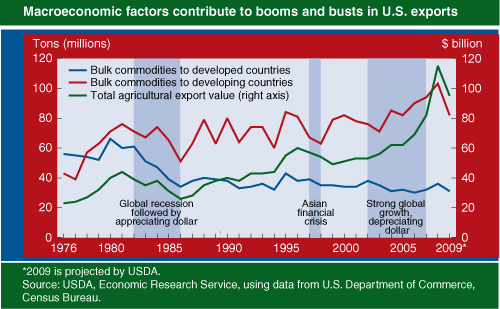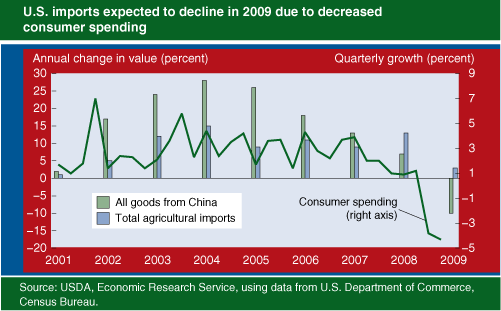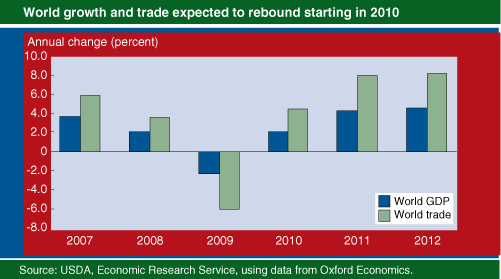A Weakening Global Economy Interrupts Agricultural Trade
- by Mark Gehlhar and Erik Dohlman
- 6/1/2009
Highlights
- The financial sector turbulence originating in the United States has had a ripple effect worldwide, curbing economic growth in nearly every country.
- Slower growth and weaker currencies in emerging markets have reduced U.S. competitiveness andagricultural exports in the short term. At the same time, reduced consumer spending domestically isdampening U.S. import growth.
- Despite the current downturn, world food demand remains stable, and demand for U.S. exports is expected to recover as developing-country growth resumes in the longer term.
The United States and most foreign economies are now entrenched in what could be the worst economic downturn of the post-World War II era. U.S. agricultural trade has not been immune to its effects—import growth is slowing, and exports are on course to decline in 2009 after several years of exceptional growth.
In the past year, financial turmoil in the United States has reverberated throughout the global economy, affecting incomes, wealth, and commerce. Exactly how all of this affects U.S. agricultural trade depends on many factors, including a host of macroeconomic drivers that link the United States to its trading partners. Currently, reduced economic growth abroad, declining U.S. consumer spending, and exchange rate movements are key forces guiding U.S. agricultural trade. Although the current climate has created market uncertainty about the immediate future and is disrupting trade, longer term prospects for resumed world growth remain positive. According to USDA’s 10-year projections, the same global economic trends that induced strong export growth before the recession are expected to support renewed trade growth when the global economy recovers. How soon trade will recover depends on the effectiveness of efforts to restore confidence and stimulate world demand.
Global Downturn Stretches Wider and Deeper Than Expected
Downturns are a natural part of business cycles—rapid global economic growth has rarely been sustained for more than a decade at a time. But until the recent crisis, the length and severity of developed-country recessions had progressively diminished over the last several decades. Although most observers expected an eventual economic downturn in the United States, the speed and severity by which world economic conditions deteriorated came as a surprise to most economic forecasters. Many economists viewed deep and prolonged recessions as a receding threat, believing that institutions governing monetary and fiscal policy tools had become more responsive and effective.
In early 2008, a worldwide recession was not anticipated by most economic forecasters. Even in mid-2008, gross domestic product (GDP) in all major developed countries, including Japan, the European Union (EU), and the United States, was expected to expand by a relatively modest but still positive rate of at least 1 to 2 percent in 2009. China’s and India’s economies were expected to continue experiencing robust annual GDP growth rates of 9 and 7 percent, respectively, and global growth was expected to approach 3 percent. But by the end of 2008, when a clearer picture emerged in the housing and job market, forecasters made sharp downward revisions from previous forecasts of global growth prospects for 2009. Central banks in Australia, the EU, Japan, and the United States began slashing interest rates to lower borrowing costs and stimulate demand. All major developed economies still slid into recession. The U.S. and the world economy subsequently entered one of the deepest downturns since World War II, with global growth turning negative.
A key indicator of the severity and breadth of the global recession is its impact on total world trade, which is expected to decline roughly 6 percent in 2009, according to Oxford Economics. Trade is being restrained not only by reduced incomes and demand but also by increased exchange rate volatility, which raises transaction costs. Trade and foreign investment transactions are less risky when exchange rate movements are relatively smooth and predictable. Trade is also being hampered by credit constraints affecting export financing, a tool used to facilitate most global commerce. The effect of this unexpected impediment to trade is a particular concern for developing country exporters.
One reason the global downturn occurred so rapidly and became so pervasive is the extent to which the economies of countries are connected by both trade flows and international transactions of financial capital. While trade became a major impetus for economic growth in recent years—particularly in countries such as China and India—reduced trade is now a cause and not just a symptom of economic weakness among many countries. In China, for example, a doubling of exports from $700 billion in 2005 to $1.4 trillion in 2008 helped boost its GDP by more than 10 percent a year over the period. In 2009, China’s economy is expected to grow less than 6 percent, largely because reduced consumer spending in developed countries is causing the first annual decline in Chinese exports in 25 years.
Because China is a major importer, its suppliers are affected as well. China’s export-oriented manufacturing sector relies heavily on inputs imported from Japan, Korea, Taiwan, and other countries. Reduced Chinese demand for coal, iron ore, and mineral imports is now contributing to a worldwide retreat in prices for these commodities. The decline in prices ended a historic 5-year boom and directly affected the economies of major suppliers, including Australia, Latin America, and some African countries.
Trade is also influenced by global financial transactions, as shifts in financial flows are rapidly reflected in exchange rate movements. Although GDP growth has fallen in nearly every country, the impact on the value of an individual country’s currency depends on the composition of its trade and net capital flows. Currency depreciation is most likely to occur in economies that rely heavily on raw commodity exports and are net borrowers of foreign capital. Lower commodity prices pose greater risks to foreign investors in commodity-dependent economies, inducing them to withdraw their capital investments. This is the case for many Latin American countries, including Argentina, Brazil, and Mexico, whose currencies have fallen precipitously since the beginning of the global downturn. The risk of currency depreciation is lower among countries that are net suppliers of financial capital and have accumulated large foreign reserves as net exporters. One such example is Japan, one of the few countries whose currency has appreciated against the U.S. dollar in the past year.
U.S. Exports Vulnerable to Macroeconomic Changes in Developing Countries
The decline in world trade, the global slowdown in growth, and a strengthening U.S. dollar are having an adverse effect on U.S. agricultural exports. Until early 2008, macroeconomic conditions—including strong foreign growth and a weaker dollar—had fostered 5 consecutive years of record U.S. agricultural exports, which peaked at over $115 billion in fiscal year 2008. The strong export performance of 2008 was in part the result of higher world commodity prices, but even at higher prices, the volume of U.S. bulk commodity exports rose by an unprecedented 25 million tons (22 percent) in just 3 years. With the global slowdown, this trend has come to an abrupt halt—U.S. agricultural exports are projected to decline by nearly $20 billion in fiscal 2009.
Until this recent reversal, the growth in U.S. agricultural exports paralleled broader trends in global agricultural trade. Propelled by income growth and more open markets, global agricultural trade grew more than 50 percent between 2000 and 2006, with developing countries accounting for 60 percent of that growth. Global agricultural trade had grown just 25 percent during the 1990s. For the U.S., developing countries such as China and Mexico represented a significant source of new demand for U.S. agricultural exports. As part of an ongoing structural shift, the share of U.S. agricultural exports destined for developing countries rose from 48 percent in the early 1990s to 65 percent in 2008.
As long as global economic growth was sustained, prospects for U.S. agricultural exports remained robust. However, the shift of export demand from developed to developing markets also brought greater vulnerability to market downturns. Trade with developing countries is subject to steeper fluctuations because consumers in these countries devote a large share of their budgets to food, and their demand for imports is particularly sensitive to changes in income, prices, and exchange rates. When developing countries experience macroeconomic instability, their governments also typically have less flexibility in their ability to use fiscal and monetary tools than developed countries, which may prolong recessions in developing countries.
Worsening economic conditions in developing countries have a disproportionate effect on demand for relatively expensive products such as dairy and meat, as consumers turn to less expensive staples. The result is lower import demand for meats and animal feed, which account for a large share of U.S. exports. The dependence of U.S. exports on economic conditions in developing countries is particularly apparent for bulk commodities—such as corn, wheat, and soybeans—whose sales have been especially responsive to macroeconomic turbulence in these countries. During the global recession in the mid-1980s and following the 1997 Asian financial crisis, demand retreated significantly as foreign economies and currencies weakened, and imports became more expensive. The share of U.S. exports accounted for by bulk commodities declined from more than 70 percent in the mid-1970s to a low of 35 percent in 2001, but bounced back to 44 percent in 2008 as developing country demand strengthened.
In the current environment of reduced income growth and erratic exchange rate movements, countries that primarily import raw commodities can be expected to search for the most competitive prices by shifting between suppliers. As they do this, the strengthening U.S. dollar against competitor currencies will have a negative effect on U.S. bulk agriculture exports. Exchange rate movements were a major factor underlying previous swings in U.S. agricultural exports. For example, Indonesia drastically reduced its grain imports from the United States and switched to other suppliers at the height of the 1997 Asian financial crisis due to a severely weakened currency. This year, the U.S. agricultural sector faces heightened competition from large commodity exporters such as Canada, Brazil, Argentina, and Australia as the U.S. dollar has strengthened against their currencies. However, sustained supply from competing exporters will also depend on the availability of credit for production and exports.
The weakening of the dollar against the Japanese yen has not prevented a decline in food imports from the United States. Japan is also in deep recession, and food imports by high-income countries tend to be relatively unresponsive to exchange rate movements.
ERS estimates that all these factors will bring a 26-percent decline in U.S. bulk commodity exports in 2009, primarily reflecting lower volumes to developing countries. Non-bulk products such as fresh horticultural products and processed foods are expected to fall by 6 percent. The combination of lower export volumes and declining commodity prices is expected to lower total agricultural exports in fiscal year 2009 by nearly $20 billion, to $95.5 billion.
U.S. Import Growth Sinks as Reduced Wealth and Incomes Drive Down Consumer Spending
Although economic growth in the U.S. slowed somewhat in the current decade compared with that in the 1990s, strength in U.S. consumer spending drove a large increase in U.S. merchandise imports. From 2002 to mid-2008, U.S. consumer spending and imports were driven by perceived wealth gains rather than domestic income or exchange rate changes. U.S. consumers drew upon equity from stock market and housing-sector gains, reduced savings, and spent more on all goods, including imports. The U.S. trade deficit grew as inflows of foreign capital prevented the dollar from weakening even further between 2002 and 2007. The influx of foreign capital helped keep U.S. interest rates low but also reduced incentives to save.
Reinforced by lower incomes, declining asset values and wealth now are having the opposite effect on consumer spending. The largest quarterly decline in consumer spending since 1980 and negative growth in U.S. merchandise imports occurred at the end of 2008. This reversal is particularly notable for U.S. imports from China, which had grown more than 15 percent annually between 2002 and 2007 but are slated to fall by more than 6 percent in 2009. Major import categories affected include apparel, electronics, equipment, and household appliances.
As with other imports, U.S. agricultural imports grew at a particularly robust pace during the past decade, more than doubling from $40 billion in 1999 to nearly $80 billion in 2008—an average annual increase of close to 10 percent. In fact, U.S. import growth has been nearly continuous since the early 1960s, and agricultural imports grew by an average of $6.6 billion annually between 2004 and 2008. While the current recession is expected to cut overall U.S. imports in 2009, agricultural imports were still expected to grow, but at a much slower pace. Agricultural imports began to weaken sharply in January 2009, reflecting the drop in consumer spending. The value of some luxury imports, such as wine, beer, and confectionery products, have declined slightly, but increases are forecast for products such as vegetable oils, fresh fruit, sugar, and cocoa.
What Does the Future Hold for U.S. Agricultural Trade?
Despite the difficult economic circumstances, the sudden downturn in U.S. agricultural exports does not reflect a fundamental long-term shift in global food demand and trade. Past experience suggests that macroeconomic swings usually have short-lived impacts (1-2 years) on U.S. trade. The long-term trend in U.S. agricultural export growth prevailed despite large swings in the mid-1980s and late 1990s caused by macroeconomic, weather, and policy events. Now, prospects for U.S. and global agricultural trade will clearly hinge on the resumption of global economic growth.
Just as the timing and severity of the recession could not be predicted, the same can be said for a recovery. The recovery will depend partly on the speed with which governments can implement policies and the efficacy of these policies in stimulating demand. Prior to the Great Depression, macroeconomic policy tools were untested and governments were ill-prepared to take decisive and immediate action. This is one reason the depression of the 1930s persisted as long as it did. Today, however, governments are deploying a broad array of macroeconomic stimulus measures. Countries that were exposed to the Asian financial crisis have learned from the experience and are better prepared. China as well as other Asian countries already are taking steps to stimulate domestic consumption.
While uncertainties remain, fiscal and monetary actions are expected to help world economic growth recover beginning in 2010, which would help boost agricultural trade along with overall global commerce in the ensuing years. According to USDA’s long-term projections to 2018, global economic growth is projected to transition back to normal longrun sustainable rates by 2011 and remain similar to historical growth rates for the remainder of the projection period.
The resumption of global growth would reestablish the foundation for strong world demand for agricultural products. As in the past decade, developing countries are expected to be the source of most of the growth in world agricultural trade. Rising incomes in developing countries translate more quickly into increased food demand because consumers are likely to consume more food and diversify their diets to include higher value goods such as red meat, poultry, and other livestock products. Rising incomes along with continued population growth is expected to increase trade in both meats and animal feeds. The USDA projections anticipate rising global trade volumes for all major food and feed grains, soybeans and soybean products, and beef, pork, and poultry. With commodity prices remaining high compared with levels preceding the 2008 price spike, the value of U.S. agricultural exports is projected to rise steadily back toward the peak level recorded in 2008. U.S. imports are also projected to continue on a steady upward path.
As in the past, the U.S. agricultural sector is positioned to profitably respond to rising incomes abroad and to demand that has shifted largely from developed to developing economies. However, favorable macroeconomic conditions alone will not sustain agricultural exports. Even when foreign demand recovers, U.S. agricultural exports will be influenced by the uncertainties of increasing farm costs and limited resources. A key issue in the future will be the ability of U.S. agricultural production to expand to meet future export demand without escalating costs. In conjunction with sustained foreign demand, long-term productivity gains will be a key component in maintaining U.S. export competitiveness.
This article is drawn from:
- Shane, M., Liefert, W.M., Morehart, M., Peters, M., Dillard, J. & Torgerson, D. (2009). The 2008/2009 World Economic Crisis: What It Means for U.S. Agriculture. U.S. Department of Agriculture, Economic Research Service. WRS--09-02.
- Gehlhar, M., Dohlman, E., Brooks, N., Jerardo, A. & Vollrath, T. (2007). Global Growth, Macroeconomic Change, and U.S. Agricultural Trade. U.S. Department of Agriculture, Economic Research Service. ERR-46.
- Westcott, P. (2009). USDA Agricultural Projections to 2018. U.S. Department of Agriculture, Economic Research Service. OCE-2009-1.
- Outlook for U.S. Agricultural Trade. (2009). Economic Research Service. AES-61..
You may also like:
- U.S. Agricultural Trade. (n.d.). U.S. Department of Agriculture, Economic Research Service.
- International Macroeconomic Data Set. (n.d.). U.S. Department of Agriculture, Economic Research Service.
- Agricultural Exchange Rate Data Set. (n.d.). U.S. Department of Agriculture, Economic Research Service.
- Fuglie, K., MacDonald, J.M. & Ball, E. (2007). Productivity Growth in U.S. Agriculture. U.S. Department of Agriculture, Economic Research Service. EB-9.





